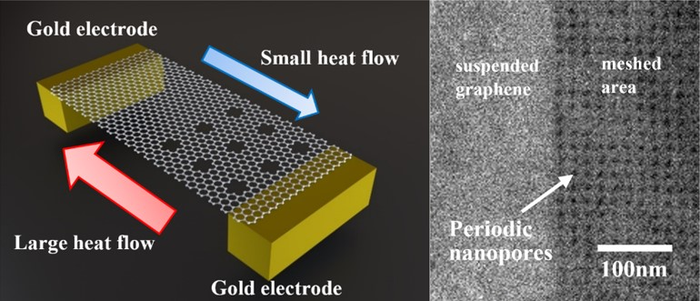Accurate control of the heat transport similar to that of the control of the electrical current has long been a scientific goal. But a high-performance thermal diode or thermal rectifier has not yet been found.
 Schematic illustration of the asymmetric graphene nanomesh device, and the periodic nanopores (nanomesh) fabricated on suspended graphene using state-of-the-art focused helium ion beam technology. Image Credit: Hiroshi Mizuta from Japan Advanced Institute of Science and Technology.
Schematic illustration of the asymmetric graphene nanomesh device, and the periodic nanopores (nanomesh) fabricated on suspended graphene using state-of-the-art focused helium ion beam technology. Image Credit: Hiroshi Mizuta from Japan Advanced Institute of Science and Technology.
At present, scientists from the Japan Advanced Institute of Science and Technology (JAIST) have illustrated a hopeful asymmetric graphene nanomesh device that exhibits a high thermal rectification ratio at low temperatures. The experiment offers a practical guideline for coming up with a high-efficiency thermal rectifier depending on the graphene nanomesh structure. The study findings were reported in the IOP Nano Futures journal.
Initially, the thermal rectifier was illustrated by Starr C. in 1936, in which the heat flux obtained from one direction is larger compared to the opposite direction as similar as an electrical diode. The traditional mechanism in bulk materials depends on the various temperature dependence of the thermal conductivities in two different composition materials.
But the majority of the illustrated results depending on this mechanism exhibit a low rectification ratio of approximately 10% to 20%. Furthermore, in nanoscale devices, it is almost impracticable to recognize the thermal conductivities for every part of a thermal rectifier. Due to this, a new strategy to design a high-performance thermal rectifier was under a lot of demand.
A phonon research group headed by Dr. Fayong Liu and Professor Hiroshi Mizuta from JAIST, in collaboration with scientists at the National Institute of Advanced Industrial Science and Technology (AIST), has illustrated that the thermal rectification phenomenon could be noted with a high ratio up to 60% on suspended asymmetric graphene nanomesh devices at low temperatures (150 K and 250 K).
The researchers used graphene nanomesh as an artificial phononic crystal structure on half the area of the heat flux channel. The nanopore diameter measures around 6 nm and the pitch is 20 nm. Having a “differential thermal leakage” method, heat flux measurement is not disturbed by the leakage of electron current via the suspended channel. The study concentrated on phonon transport properties of this type of new device structure.
This research outcome is a significant advancement towards the practical application of graphene to thermal management. It is also a notable milestone for our final aim to apply graphene to build a greener world.
Hiroshi Mizuta, Professor, Japan Advanced Institute of Science and Technology
Hiroshi Mizuta is the head of Mizuta lab which concentrates on basic physics and possible applications of graphene-based devices. This study offers a systematic method to improve the performance of the thermal rectifier and also increase the chance to extend it to room temperature applications.
Journal Reference:
Liu, F., et al. (2021) Thermal rectification on asymmetric suspended graphene nanomesh devices. Nano Futures. doi.org/10.1088/2399-1984/ac36b5.